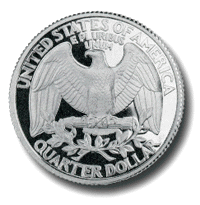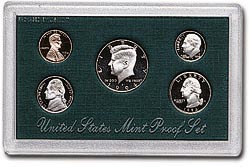|
Proof Coins & Proof Sets
A "proof" coin is a specimen striking for
presentation, souvenir, exhibition, or numismatic purposes, but not intended for general
circulation. Proof coins prior to 1968 were struck only at the Philadelphia mint except in
a few rare instances in which presentation pieces were made at branch mints. Current proof
sets are made at San Francisco and West Point.
The term "proof" refers not to the coin's
condition, but rather to its method of manufacture. Normal production coins, even in
mint state condition, have coruscating, frosty luster, soft details, and minor
imperfections. Proof coins are easily distinguished by their sharp detail, high wire edge,
and extremely brilliant, mirror-like surface. All proof coins are originally sold by the
mint at a premium.
The United States Mint started producing Proof coins as
early as the 1850's. Very few proof coins were minted prior to 1856. Some of these
are presentation pieces or "patterns" made for the demonstration of new designs
prior to regular issue production.
This special process of manufacturing involves specially
selected planchets (the blanks that the coins are struck from) as well as dies that have
been highly polished. The planchets are hand fed into the press and special care is taken
in the handling and packaging of these coins.
 How Modern Proof Coins Are Made How Modern Proof Coins Are Made
1.Select dies are inspected for perfection and
are highly polished and cleaned. They are again wiped clean or polished after
approximately 15 to 25 impressions and are replaced frequently to avoid imperfections from
worn dies.
2.Coinage blanks are polished and cleaned to
assure high quality strikes.
3.The blanks are then hand fed into the
coinage press one by one, each blank receiving two or more blow from the dies to bring up
sharp, high relief details. The coinage process is done at slow speed with extra pressure.
4.Finished proofs are individually inspected
and are handled by gloves or tongs.
5.After a final inspection by packers, they
are sonically sealed in special plastic cases.
Proof coins usually receive two strikes from the coin press
which gives them an increased sharpness in detail. Because the planchets and dies were
highly polished before striking the coin will also have an extremely brilliant
mirror-like
surface. Some early Proof coins will exhibit a frosted effect. These frosted Proofs are
highly sought after prizes to the serious collector. In recent years Proof coins have
purposely been produced with a very strong cameo effect which gives them a
mirror-like
field and a contrasting frosty effect on all the raised surfaces of the coin.
Single Proof coins were available from the Mint, at a
premium over their face value, in the years in which they were minted. In 1936 the Mint
started offering Proof coins in complete sets, cent, nickel, dime, quarter and half
dollar. These sets originally sold for $1.87 each. In 1942 there were some Proof sets
issued with two nickels. The regular composition as well as the silver. The production and
sale of Proof sets was suspended in 1943 and was not resumed until 1950.
Proof sets have always been a very popular part of
numismatics. Some collector's will collect one set of every year issued from 1936 to
present date while others will start their collection with the more affordable "flat
pack" issues from 1955 and continue on up to present day issues. Another popular way
these sets are collected is by various nostalgic years to commemorate a significant
occasion like an Anniversary, a Birth Year, Wedding Year, Graduation Day, etc.
Occasionally "proof-like" coins are encountered,
most frequently in Morgan dollars. These are specimens from the first few impressions of
regular coinage dies from a given mint. They are not true proof coins, but have many of
the characteristics of a proof coin and usually command a premium.
Matte Proof Coins (1908 - 1916)
Matte proof cents, nickels, and gold coins
were issued individually for sale to collectors. A few 1921 and 1922 silver dollar
matte proofs are also known to exist. These proofs have a granular surface instead of a
mirrored finish.
Proof Sets (1936 - Present)
From 1936 till approximately mid 1955 all Proof sets were
issued in small cardboard boxes in which the coins were housed in cellophane envelopes.
Most of the early sets have since been removed from the cardboard boxes and the coins
placed in a plastic holder to protect them from tarnishing.
From late 1955 until 1964 the Mint packaged Proof coins in
a flat, transparent cellophane holder. These sets are referred to in the industry as
"flat packs." There were no Proof sets issued in 1965, 1966 and 1967. In these
years the mint produced Special Mint Sets. These coins are almost proof-like in appearance.
Starting in 1968 the Mint switched the production of Proof
coins from the Philadelphia facility to the San Francisco Mint. All of the Proof coins
produced from 1968 will have the "S" Mintmark on them. There are some coins that
in error did not receive the "S" Mintmark and these are very Rare and valuable.
The packaging was also changed in 1968 to a more rigid plastic case which has gone through
several design changes since than.
 The 1960 and 1970 large-date
and small-date (SD) sets are distinguished by the size of the date on the cent. The 1976
three-piece set contains the quarter, half dollar and dollar with the Bicentennial design
and they are 40% silver. The 1975 and 1976 sets also contain the quarter, half dollar and
dollar dated 1976 with the Bicentennial design. But these coins are made of a
copper-nickel composition. The 1979 and 1981 Type II Proof sets have clearer Mintmarks
than the Type I sets for those years and are much scarcer and higher in price. The 1960 and 1970 large-date
and small-date (SD) sets are distinguished by the size of the date on the cent. The 1976
three-piece set contains the quarter, half dollar and dollar with the Bicentennial design
and they are 40% silver. The 1975 and 1976 sets also contain the quarter, half dollar and
dollar dated 1976 with the Bicentennial design. But these coins are made of a
copper-nickel composition. The 1979 and 1981 Type II Proof sets have clearer Mintmarks
than the Type I sets for those years and are much scarcer and higher in price.
All Proof sets issued from 1936 to 1972 include the cent,
nickel, dime, quarter and half dollar; from 1973 till 1981 the dollar was added and then
removed from the sets in 1982. Prestige Proof sets were first produced in 1983 and
will also contain a Commemorative dollar for that year. The production of Prestige Proof
sets was suspended with the last issued being 1997. There are also Silver Proof sets
starting in 1992. These sets will have a 90% silver dime, quarter and half dollar. The
Silver premier sets are similar to the Silver sets and differ only by being in a more
deluxe case. The Mint also produces separately priced proof versions of American
Eagles for collectors.
|

